Abstract
Background
Methods
Results
References
Supplementary Material
Supplemental Data Figure S1
Fig. 1
Overnight 8-hr UGE and UGCR. (A) Distribution of overnight 8-hr UGE values. Outliers of overnight 8-hr UGE above 100,000 mg (N = 2) were excluded in the graph. (B, C) Comparison of the correlation coefficient values between UGCRs and UNCRs.
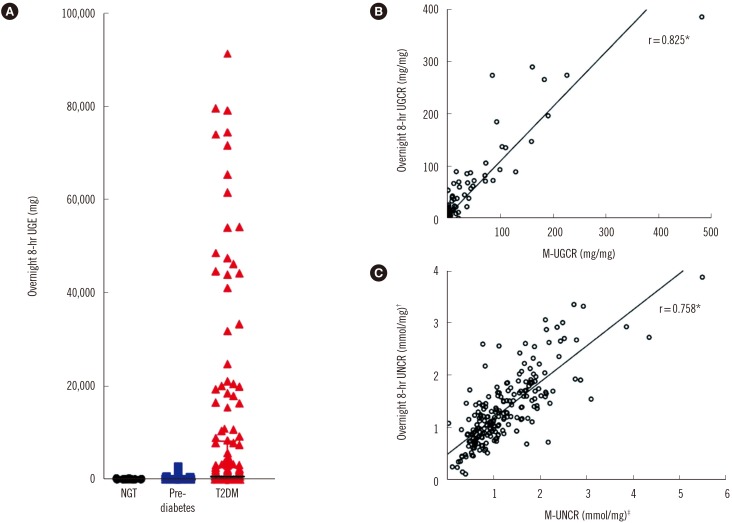
Fig. 2
Bland-Altman plot for assessing the agreement between the overnight 8-hr UGCR and M-UGCR.
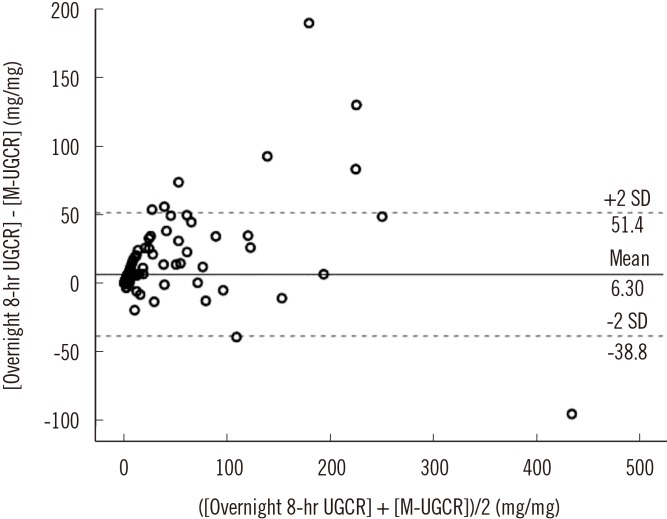
Table 1
Baseline demographic and laboratory characteristics of participants
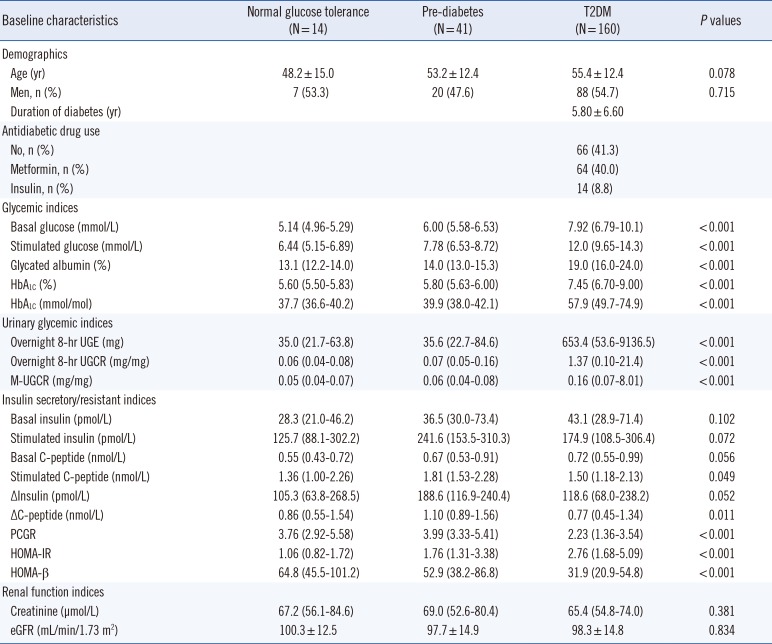
Continuous variables were described as mean±SD for parametric variables and median (interquartile range) for nonparametric variables.
Abbreviations: T2DM, type 2 diabetes mellitus; HbA1c, glycated hemoglobin; UGE, urinary glucose excretion; UGCR, urinary glucose-to-creatinine ratio; M-UGCR, first-voided morning spot UGCR; PCGR, postprandial C-peptide-to-glucose ratio; HOMA-IR, homeostatic model assessment of insulin resistance; HOMA-β, homeostatic model assessment of pancreatic β-cell function; eGFR, estimated glomerular filtration rate.
Table 2
Intraclass correlation coefficient (ICC) between the overnight 8-hr UGCR and M-UGCR
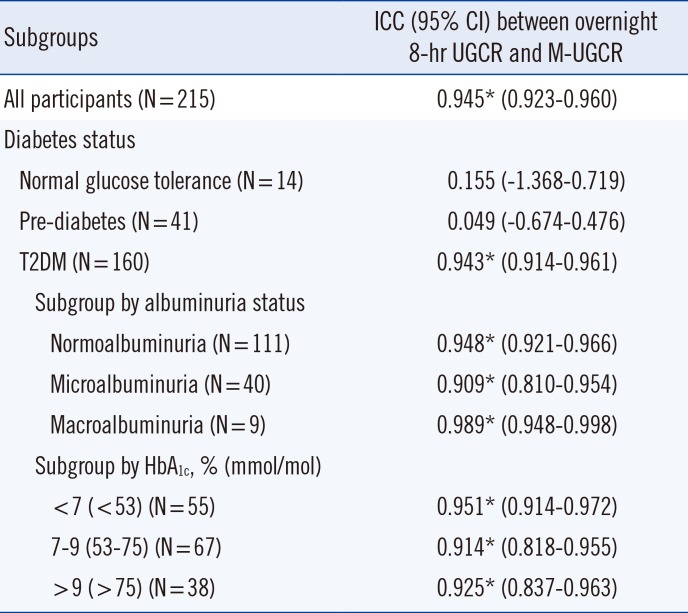
Normoalbuminuria, overnight 8-hr ACR <3.4 mg/mmol; microalbuminuria, 3.4 ≤overnight 8-hr ACR <34 mg/mmol; macroalbuminuria, overnight 8-hr ACR ≥34 mg/mmol.
*P<0.001.
Abbreviations: UGCR, urinary glucose-to-creatinine ratio; M-UGCR, first-voided morning spot UGCR; T2DM, type 2 diabetes mellitus; HbA1c, glycated hemoglobin; ACR, albumin-to-creatinine ratio; CI, confidence interval.
Table 3
Correlation between UGE or UGCRs and other parameters in T2DM (N=160)
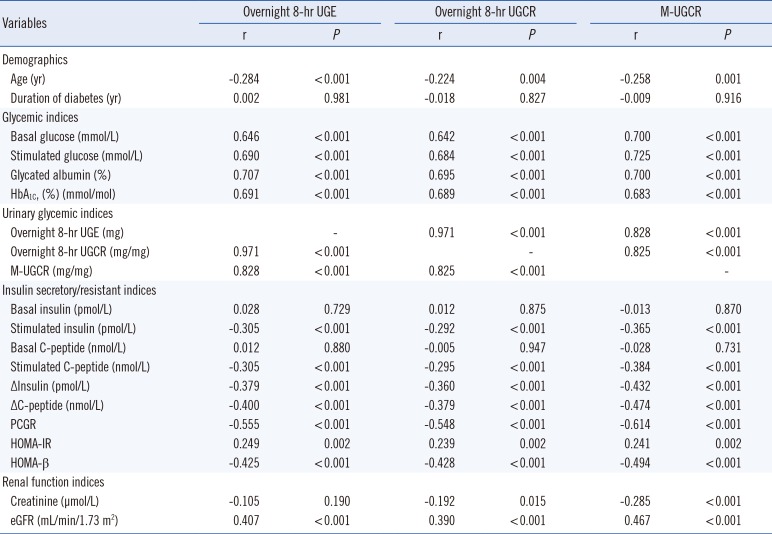
Abbreviations: T2DM, type 2 diabetes mellitus; UGE, urinary glucose excretion; UGCR, urinary glucose-to-creatinine ratio; M-UGCR, first-voided morning spot UGCR; HbA1c, glycated hemoglobin; PCGR, postprandial C-peptide-to-glucose ratio; HOMA-IR, homeostatic model assessment of insulin resistance; HOMA-β, homeostatic model assessment of pancreatic β-cell function; eGFR, estimated glomerular filtration rate.
Table 4
Multiple linear regression models for overnight 8-hr UGE or M-UGCR in T2DM

Logarithm-transformed values of overnight 8-hr UGE and M-UGCR were used for analysis.
Model 1: adjusted for age, sex, duration of diabetes, basal glucose, stimulated glucose, GA, HbA1c, and eGFR.
Model 2: adjusted for PCGR, ΔInsulin, ΔC-peptide, HOMA-IR, and HOMA-β.
Bold values indicate statistical significance.
Abbreviations: T2DM, type 2 diabetes mellitus; UGE, urinary glucose excretion; M-UGCR, first-voided morning spot urinary glucose-to-creatinine ratio; STD, standardized; PCGR, postprandial C-peptide-to-glucose ratio; GA, glycated albumin; HOMA-IR, homeostatic model assessment of insulin resistance; HOMA-β, homeostatic model assessment of pancreatic β-cell function; eGFR, estimated glomerular filtration rate; HbA1c, glycated hemoglobin.




 PDF
PDF ePub
ePub Citation
Citation Print
Print


 XML Download
XML Download